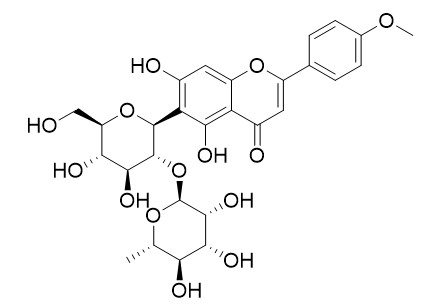Isomargaritene
Antioxidant activity.
Inquire / Order:
manager@chemfaces.com
Technical Inquiries:
service@chemfaces.com
Tel:
+86-27-84237783
Fax:
+86-27-84254680
Address:
1 Building, No. 83, CheCheng Rd., Wuhan Economic and Technological Development Zone, Wuhan, Hubei 430056, PRC
Providing storage is as stated on the product vial and the vial is kept tightly sealed, the product can be stored for up to
24 months(2-8C).
Wherever possible, you should prepare and use solutions on the same day. However, if you need to make up stock solutions in advance, we recommend that you store the solution as aliquots in tightly sealed vials at -20C. Generally, these will be useable for up to two weeks. Before use, and prior to opening the vial we recommend that you allow your product to equilibrate to room temperature for at least 1 hour.
Need more advice on solubility, usage and handling? Please email to: service@chemfaces.com
The packaging of the product may have turned upside down during transportation, resulting in the natural compounds adhering to the neck or cap of the vial. take the vial out of its packaging and gently shake to let the compounds fall to the bottom of the vial. for liquid products, centrifuge at 200-500 RPM to gather the liquid at the bottom of the vial. try to avoid loss or contamination during handling.
Kasetsart University2022, ethesis.1144.
ACS Food Sci. Technol.2023, 3(2):273-282.
Eur J Pharmacol.2020, 889:173589.
PLoS One.2020, 15(2):e0220084.
Antioxidants (Basel).2020, 9(2): E119
J of Liquid Chromatography & Related Technologies2024, 47(1-5):14-25.
J Nat Med.2022, 76(1):59-67.
Cell Death Differ.2021, 1-8.
J Ethnopharmacol.2024, 324:117775.
Curr Issues Mol Biol.2023, ;45(2):1601-1612.
Related and Featured Products
Food Chem . 2016 Apr 15;197(Pt A):1-6.
Phenolic content, antioxidant activity and effective compounds of kumquat extracted by different solvents[Pubmed:
26616917]
The total phenolic and flavonoid content of extracts from peel of kumquat were higher than those from pulp, and those extracted from immature kumquat were higher than those from mature kumquat. The highest levels of phenolic and flavonoid content were obtained in hot water extracts. The flavonoids of kumquat extracted from hot water were mainly soluble conjugated compounds, including C-glycosides, such as 3',5'-di-C-β-glucopyranosylphloretin (DGPP), acacetin 8-C-neohesperidoside (margaritene), acacetin 6-C-neohesperidoside (Isomargaritene), apigenin 8-C-neohesperidoside, and O-glycosides, such as acacetin 7-O-neohesperidoside (fortunellin), isosakuranetin 7-O-neohesperidoside (poncirin) and apigenin 7-O-neohesperidoside (rhoifolin). A positive relationship existed between total phenolic content and DPPH scavenging potency (p<0.001). Total flavonoid content showed a similar correlation (p<0.001) to DPPH scavenging potency. The effective flavonoids contributing to antioxidant activity were DGPP and apigenin 8-C-neohesperidoside, which could be extracted in high amounts, by hot water at 90°C, from immature kumquat peel.



